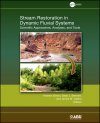About this book
Stream Restoration in Dynamic Fluvial Systems brings together leading contributors in stream restoration science to provide comprehensive consideration of process-based approaches, tools, and applications of techniques useful for the implementation of sustainable restoration strategies. Stream restoration is a catch-all term for modifications to streams and adjacent riparian zones undertaken to improve geomorphic or ecologic function, or both, structure, and integrity of river corridors, and it has become a multibillion dollar industry in the United States.
A vigorous debate currently exists in research and professional communities regarding the approaches, applications, and tools most effective in designing, implementing, and assessing stream restoration strategies given a multitude of goals, objectives, stakeholders, and boundary conditions. More importantly, stream restoration as a research-oriented academic discipline is, at present, lagging stream restoration as a rapidly evolving, practitioner-centric endeavor.
Stream Restoration in Dynamic Fluvial Systems addresses these main areas:
- Concepts in stream restoration
- River mechanics and the use of hydraulic structures
- Modeling in restoration design
- Ecology, ecologic indices, and habitat
- Geomorphic approaches to stream and watershed management
- Sediment considerations in stream restoration
Stream Restoration in Dynamic Fluvial Systems will appeal to scholars, professionals, and government agency and institute researchers involved in examining river flow processes, river channel changes and improvements, watershed processes, and landscape systematics.
Contents
Preface
Sean J. Bennett, Janine M. Castro, and Andrew Simon ix
Section I: Introduction
The Evolving Science of Stream Restoration
Sean J. Bennett, Andrew Simon, Janine M. Castro, Joseph F. Atkinson, Colleen E. Bronner, Stacey S. Blersch, and Alan J. Rabideau 1
Section II: General Approaches
Conceptualizing and Communicating Ecological River Restoration
Robert B. Jacobson and Jim Berkley 9
Setting Goals in River Restoration: When and Where Can the River "Heal Itself"?
G. Mathias Kondolf 29
Stream Restoration Benefits
J. Craig Fischenich 45
Natural Channel Design: Fundamental Concepts, Assumptions, and Methods
David L. Rosgen 69
Geomorphological Approaches for River Management and Restoration in Italian and French Rivers
Massimo Rinaldi, Hervé Piégay, and Nicola Surian 95
Section III: Stream Hydrology and Hydraulics
Hydraulic Modeling of Large Roughness Elements With Computational Fluid Dynamics for Improved Realism in Stream Restoration Planning
David L. Smith, Jeffrey B. Allen, Owen Eslinger, Miguel Valenciano, John Nestler, and R. Andrew Goodwin 115
Design Discharge for River Restoration
Philip J. Soar and Colin R. Thorne 123
Scale-Dependent Effects of Bank Vegetation on Channel Processes: Field Data, Computational Fluid Dynamics Modeling, and Restoration Design
Brian P. Bledsoe, Shaun K. Carney, and Russell J. Anderson 151
Hyporheic Restoration in Streams and Rivers
Erich T. Hester and Michael N. Gooseff 167
Section IV: Habitat Essentials
Diversity of Macroinvertebrate Communities as a Reflection of Habitat Heterogeneity in a Mountain River Subjected to Variable Human Impacts
Bartlomiej Wyzga, Pawel Oglecki, Artur Radecki-Pawlik, and Joanna Zawiejska 189
Combining Field, Laboratory, and Three-Dimensional Numerical Modeling Approaches to Improve Our Understanding of Fish Habitat Restoration Schemes
Pascale M. Biron, David M. Carré, Robert B. Carver, Karen Rodrigue-Gervais, and Sarah L. Whiteway 209
Connectivity and Variability: Metrics for Riverine Floodplain Backwater Rehabilitation
F. D. Shields Jr., Scott S. Knight, Richard Lizotte Jr., and Daniel G. Wren 233
Quantitatively Evaluating Restoration Scenarios for Rivers With Recreational Flow Releases
Martin W. Doyle and Randall L. Fuller 247
Section V: Sediment Transport Issues
Sediment Source Fingerprinting (Tracing) and Sediment Budgets as Tools in Targeting River and Watershed Restoration Programs
A. C. Gellis and D. E. Walling 263
Closing the Gap Between Watershed Modeling, Sediment Budgeting, and Stream Restoration
Sean M. C. Smith, Patrick Belmont, and Peter Wilcock 293
Mitigating Channel Incision via Sediment Input and Self-Initiated Riverbank Erosion at the Mur River, Austria
M. Klösch, R. Hornich, N. Baumann, G. Puchner, and H. Habersack 319
Salmon as Biogeomorphic Agents in Gravel Bed Rivers: The Effect of Fish on Sediment Mobility and Spawning Habitat
Marwan A. Hassan, Ellen L. Petticrew, David R. Montgomery, Allen S. Gottesfeld, and John F. Rex 337
Section VI: Structural Approaches
Restoring Habitat Hydraulics With Constructed Riffles
Robert Newbury, David Bates, and Karilyn Long Alex 353
Pool-Riffle Design Based on Geomorphological Principles for Naturalizing Straight Channels
Bruce L. Rhoads, Frank L. Engel, and Jorge D. Abad 367
Controlling Debris at Bridges
Peggy A. Johnson and Scott A. Sheeder 385
Seeing the Forest and the Trees: Wood in Stream Restoration in the Colorado Front Range, United States
Ellen Wohl 399
Geomorphic, Engineering, and Ecological Considerations When Using Wood in River Restoration
Tim Abbe and Andrew Brooks 419
Section VII: Model Applications
Development and Application of a Deterministic Bank Stability and Toe Erosion Model for Stream Restoration
Andrew Simon, Natasha Pollen-Bankhead, and Robert E. Thomas 453
Bank Vegetation, Bank Strength, and Application of the University of British Columbia Regime Model to Stream Restoration
Robert G. Millar and Brett C. Eaton 475
Application of the CONCEPTS Channel Evolution Model in Stream Restoration Strategies
Eddy J. Langendoen 487
Practical Considerations for Modeling Sediment Transport Dynamics in Rivers
Yantao Cui, Scott R. Dusterhoff, John K. Wooster, and Peter W. Downs 503
AGU Category Index 529
Index 531
Customer Reviews






































